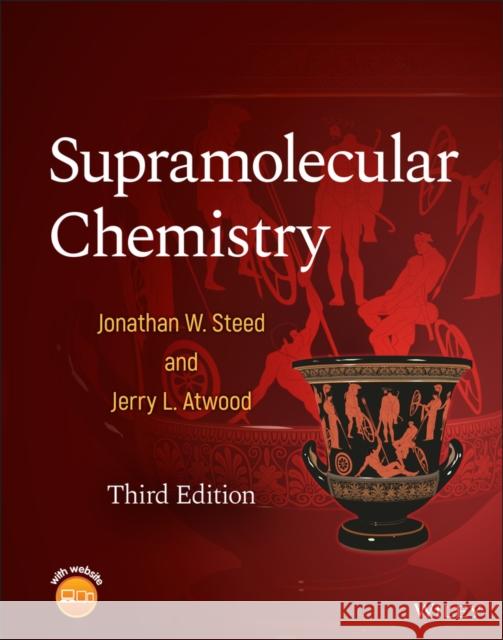Supramolecular Chemistry » książka



Supramolecular Chemistry
ISBN-13: 9781119582519 / Angielski / Twarda / 2022 / 1216 str.
Supramolecular Chemistry
ISBN-13: 9781119582519 / Angielski / Twarda / 2022 / 1216 str.
(netto: 467,28 VAT: 5%)
Najniższa cena z 30 dni: 487,62
ok. 30 dni roboczych
Dostawa w 2026 r.
Darmowa dostawa!
About the Authors xviiPreface to the Third Edition xixAcknowledgements xxiAbout the Front Cover xxiiiAbout the Companion Website xxiiiChapter 1 Concepts 11.1 Definition and Development of Supramolecular Chemistry 11.2 Classification of Supermolecule Formation 41.3 Receptors, Coordination, and the Lock and Key Analogy 111.4 Binding Constants 141.5 Cooperativity, Multivalency, and the Chelate Effect 291.6 Preorganisation and Complementarity 361.7 Thermodynamic and Kinetic Selectivity, and Discrimination 381.8 Nature of Supramolecular Interactions 401.9 Solvation Effects 571.10 Supramolecular Concepts and Design 611.11 Practical Applications of Supramolecular Chemistry 73Chapter 2 The Supramolecular Chemistry of Life 832.1 Biological Inspiration for Supramolecular Chemistry 832.2 Alkali Metal Cations in Biochemistry 842.3 Porphyrins and Tetrapyrrole Macrocycles 962.4 Supramolecular Features of Plant Photosynthesis 992.5 Uptake and Transport of Oxygen by Haemoglobin 1062.6 Enzymes and Coenzymes 1112.7 Signalling: Neurotransmitters, Hormones, and Pheromones 1172.8 DNA and the Genetic Code 1212.9 Biochemical Self-Assembly 1342.10 Biomineralisation 1372.11 Emergence of Life 141Chapter 3 Cation-Binding Hosts 1473.1 Introduction to Coordination Chemistry 1473.2 Podands 1533.3 The Crown and Lariat Ethers 1583.4 The Cryptands 1633.5 The Spherands 1653.6 Nomenclature of Cation-Binding Macrocycles 1673.7 Selectivity of Cation Complexation 1693.8 Solution Behaviour and Applications of Crowns and Cryptands 1843.9 Macrocycle Synthesis: The Template Effect and High Dilution 1893.10 Soft Ligands for Soft Metal Ions 1963.11 Proton Binding: The Simplest Cation 2123.12 Complexation of Organic Cations 2173.13 Alkalides and Electrides 2313.14 The Calixarenes 2343.15 Carbon Donor and pi-acid Ligands 2443.16 The Siderophores 250Chapter 4 Anion Binding 2654.1 Introduction 2654.2 Biological Anion Receptors 2684.3 Concepts in Anion Host Design 2744.4 Cationic Receptors 2834.5 Neutral Receptors 3004.6 Boron Based Receptors and Lewis Acid Chelates 3194.7 Metal-Containing Receptors 3234.8 Anion-Binding Helices 3334.9 Anion Transport 336Chapter 5 Ion-Pair Receptors 3515.1 Simultaneous Anion and Cation Binding 3515.2 Labile Coordination Complexes and Cages as Anion Hosts 3675.3 Receptors for Zwitterions 375Chapter 6 Molecular Guests in Solution 3816.1 Molecular Hosts and Molecular Guests 3816.2 Intrinsic Curvature: Guest Binding by Cavitands 3846.3 Cyclodextrins 4016.4 Molecular Tweezers, Clips and Clefts 4116.5 Cyclophane Hosts 4156.6 Constructing a Solution Host from Clathrate-Forming Building Blocks: The Cryptophanes 4406.7 Covalent Cages: Carcerands and Hemicarcerands 4506.8 Coordination Cages 4606.9 Halogen-Bonded Complexes 461Chapter 7 Solid-State Inclusion Compounds 4697.1 Nomenclature and Thermochemical Aspects 4697.2 Porosity and Gas Sorption 4737.3 Clathrate Hydrates 4797.4 Urea and Thiourea Clathrates 4867.5 Channel Clathrates 4927.6 Polarity Formation 4977.7 Hydroquinone, Phenol, Dianin's Compound, and the Hexahost Strategy 5017.8 Macrocyclic Clathrates 5047.9 Covalent Cages 5227.10 Gas Sorption by Coordination Complex Hosts 527Chapter 8 Crystal Engineering 5378.1 Concepts 5378.2 Crystal Nucleation and Growth 5508.3 Understanding Crystal Structures 5748.4 The Cambridge Structural Database 5898.5 Polymorphism 5928.6 Co-crystals 6038.7 Solid State Transformations 6178.8 Crystal Structure Prediction 6248.9 Common and Exotic Supramolecular Synthons 6298.10 Halogen Bonding 6408.11 Bending and Jumping Crystals 642Chapter 9 Network Solids 6559.1 What are Network Solids? 6559.2 Zeolites 6629.3 Layered Solids and Intercalates 6709.4 In the Beginning: Hoffman Inclusion Compounds and Werner Clathrates 6769.5 Coordination Polymers 6799.6 Porous Metal-Organic Frameworks 6969.7 Covalent Organic Frameworks 716Chapter 10 Self-Assembly 72710.1 Introduction 72710.2 Proteins and Foldamers: Single-Molecule Self-Assembly 73310.3 Biochemical Self-Assembly 73610.4 Self-Assembly in Synthetic Systems: Kinetic and Thermodynamic Considerations 73910.5 Helicates and Helical Assemblies 75510.6 Self-Assembling Coordination Compounds 76810.7 Self-Assembly of Closed Complexes by Hydrogen Bonding 79310.8 Templated Assembly of Porphyrin Arrays 80510.9 Programmed Assembly with Biomolecules 807Chapter 11 The Mechanical Bond 81511.1 Scope and Importance of Mechanical Bonding and Mechanostereochemistry 81511.2 Catenanes and Rotaxanes 81611.3 Molecular Knots 84611.4 Borromean Rings and Multiply Interlocked Catenanes 85711.5 Interpenetrated Cages 86011.6 An Unusual Thring 861Chapter 12 Molecular Devices and Machines 86712.1 Introduction 86712.2 Supramolecular Photochemical Devices 87012.3 Information and Signals: Semiochemistry and Sensing 89012.4 Molecule-Based Electronics 90912.5 Molecular Analogues of Mechanical Machines 923Chapter 13 Biological Mimics and Supramolecular Catalysis 94513.1 Introduction 94513.2 Cyclodextrins as Enzyme Mimics 94813.3 Corands as ATPASE Mimics 95313.4 Cation-Binding Hosts as Transacylase Mimics 95513.5 Metallobiosites 95813.6 Enzyme Mimetic Materials 97713.7 Ion Channel Mimics 97813.8 Supramolecular Catalysis 985Chapter 14 Interfaces and Liquid Assemblies 100314.1 Order in Liquids 100314.2 Surfactants and Interfacial Ordering 100514.3 Liquid Crystals 101814.4 Polyamorphous Liquids 103014.5 Ionic Liquids and Deep Eutectic Solvents 103214.6 Liquid Clathrates 103314.7 Porous Liquids 1036Chapter 15 Supramolecular Materials 104315.1 Introduction 104315.2 Dendrimers 104415.3 Fractal Assemblies 106215.4 Covalent Polymers with Supramolecular Properties 106315.5 Self-Assembled Supramolecular Polymers 106815.6 Mechanically Interlocked Materials 107715.7 Supramolecular Gels 108415.8 Polymeric Liquid Crystals 109115.9 Biological Self-Assembled Materials 1093Chapter 16 Dynamic Covalent Bonding and Complex Systems 110116.1 Chemistry Out of Equilibrium 110116.2 Dynamic Combinatorial Libraries 110216.3 Self-Replication 110616.4 Shapeshifting Molecules 111116.5 Dissipative Self-Assembly 1113Chapter 17 Nanochemistry 111917.1 When Is Nano Really Nano? 111917.2 Nanotechnology: The 'Top-Down' and 'Bottom-Up' Approaches 112017.3 Templated and Biomimetic Morphosynthesis 112117.4 Nanoscale Photonics 112417.5 Microfabrication, Nanofabrication and Soft Lithography 112617.6 Assembly and Manipulation on the Nanoscale 113217.7 Nanoparticles 114417.8 Endohedral Fullerenes, Nanotubes and Graphene 1152Index 1165
Jonathan W. Steed is Professor of Inorganic Chemistry at Durham University, a Ph.D. graduate of University College London. He is the recipient of the RSC Meldola, Corday-Morgan and Tilden Prizes, Durham's Vice Chancellor's Award for Excellence in Postgraduate Teaching, the Bob Hay Lectureship, and the Royal Society Wolfson Research Merit Award.Jerry L. Atwood is the Curator's Distinguished Professor at the University of Missouri - Columbia. He obtained his Ph.D. in 1968 at the University of Illinois. He is the co-founder of the journals Supramolecular Chemistry and the Journal of Inclusion Phenomena. He is the recipient of the Izatt-Christiansen Prize in Supramolecular Chemistry.
1997-2025 DolnySlask.com Agencja Internetowa
KrainaKsiazek.PL - Księgarnia Internetowa









